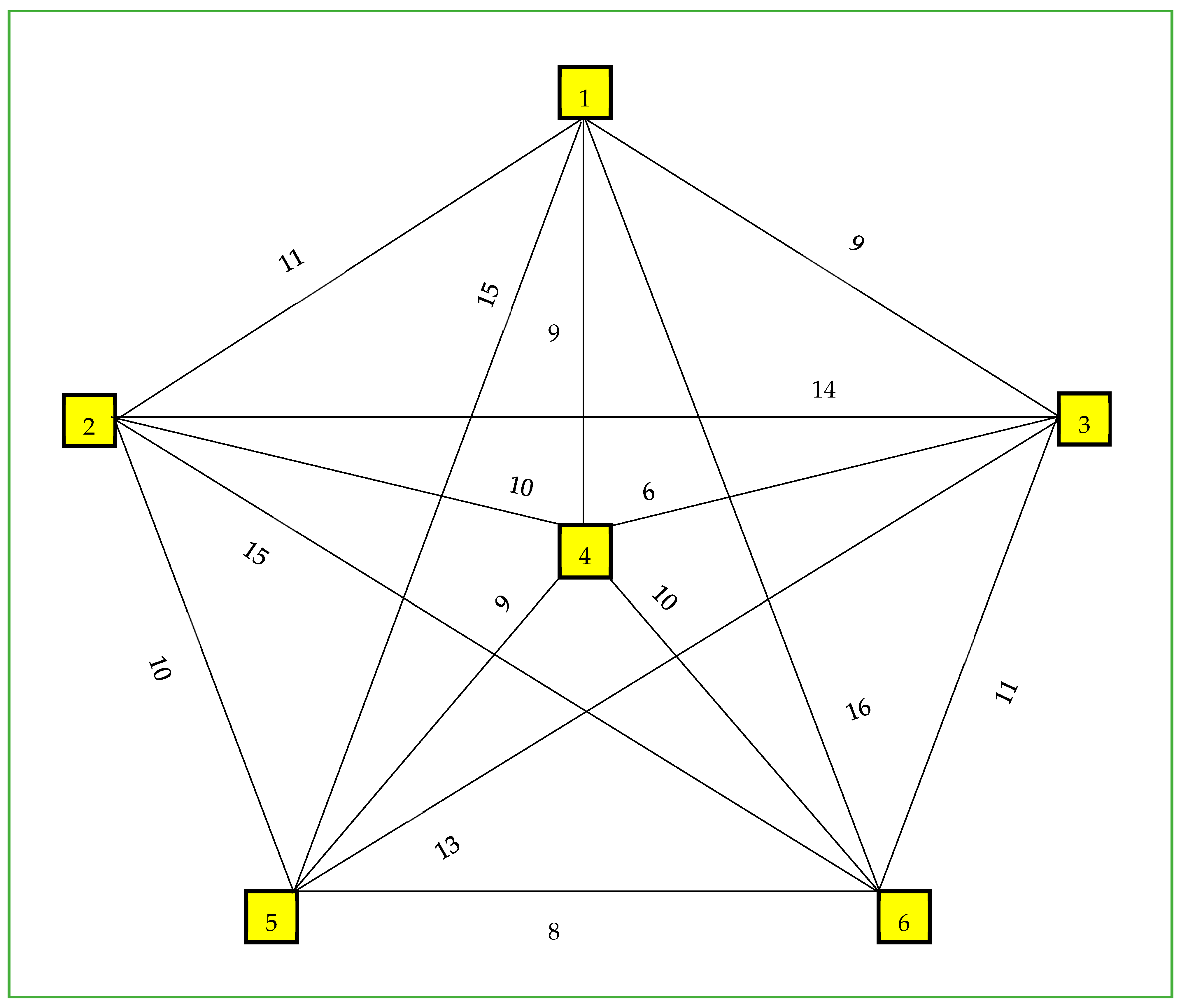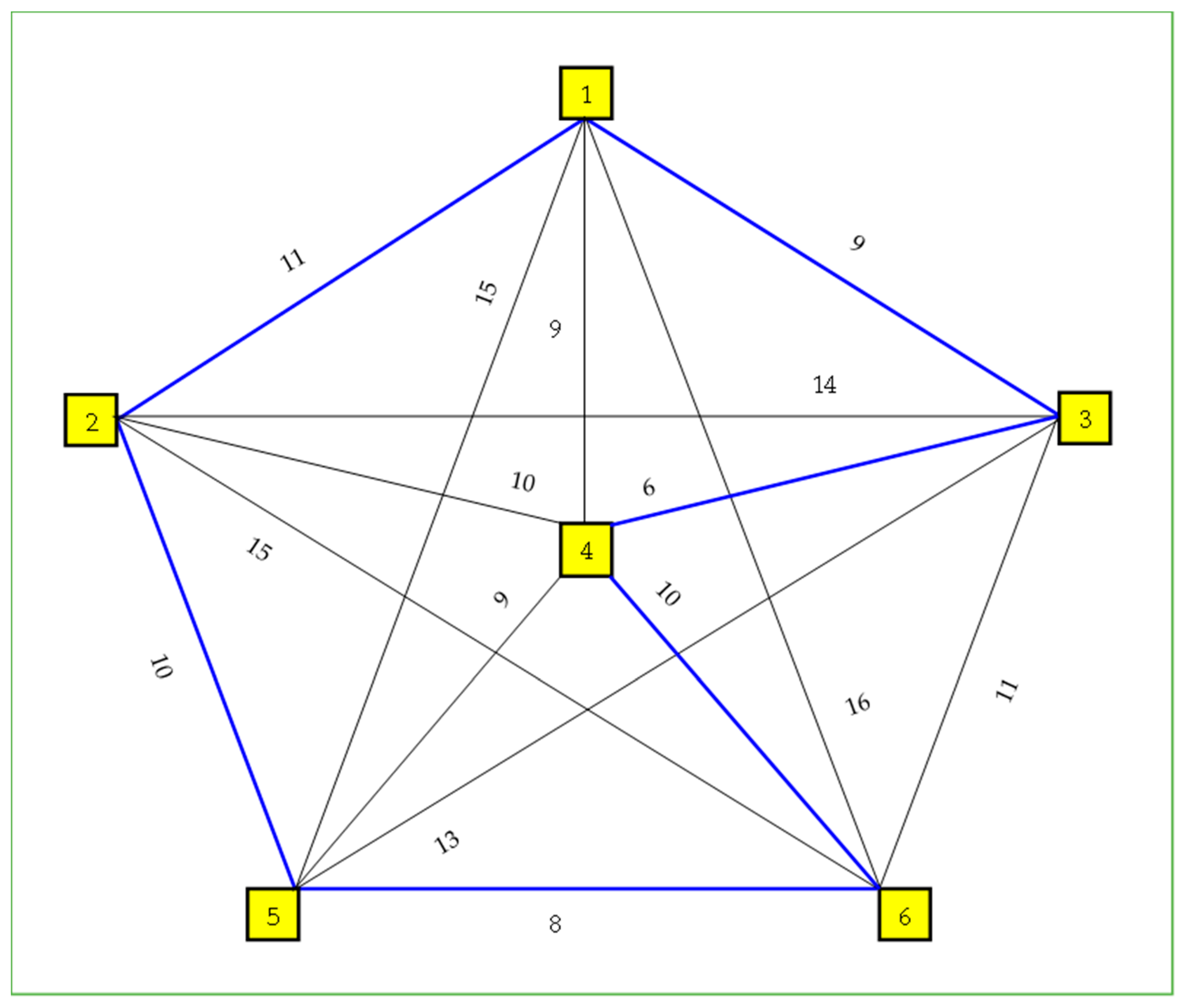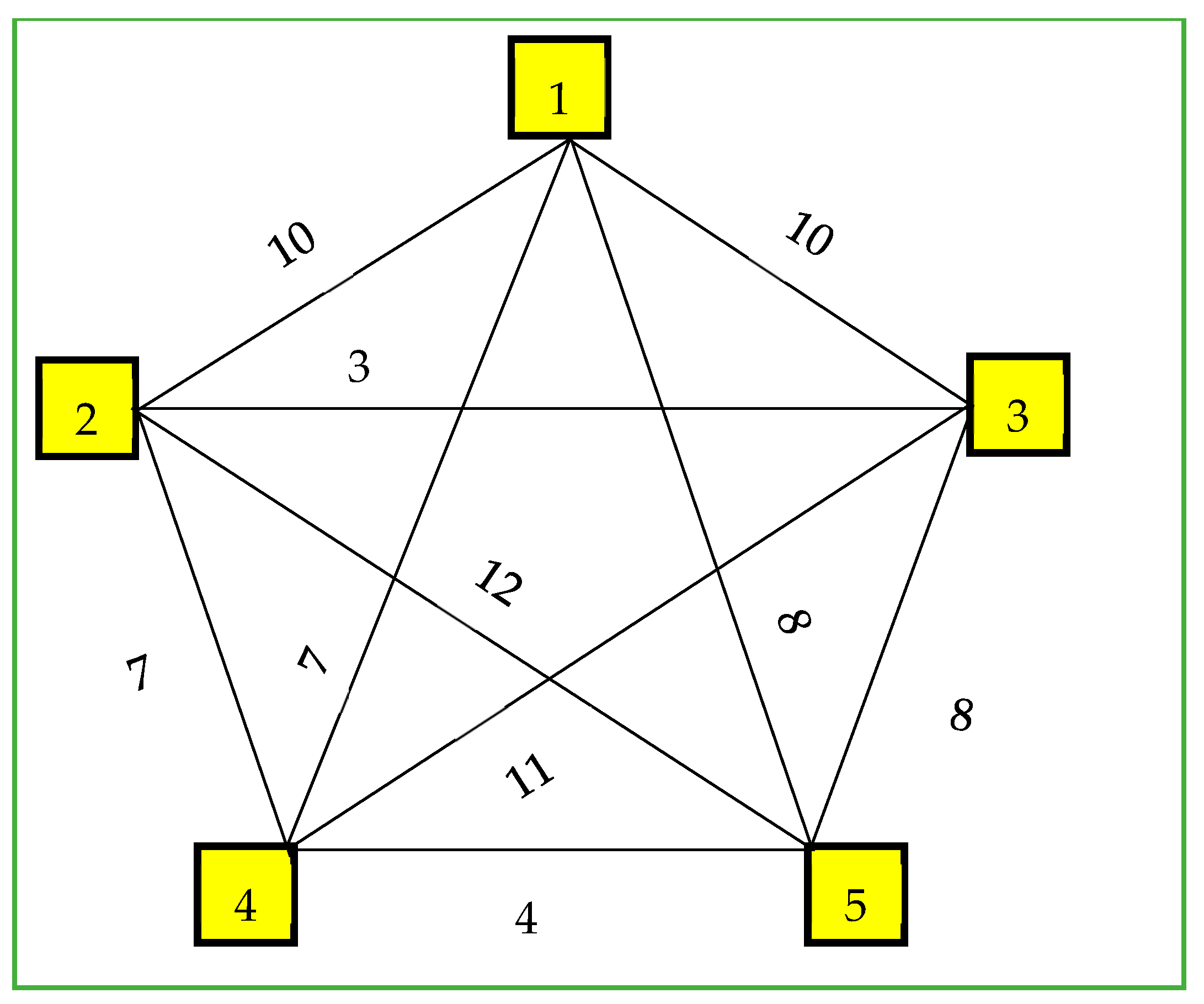The travelling salesman problem (TSP) through the K set of nodes was considered by Srivastava et al. [
7] and Garg et al. [
8]. Kumar et al. [
9] developed a TSP heuristic that is based on the Minimum spanning tree (MST). Kumar et al. [
10] established a relationship between the MST under the index restriction and the Minimum travelling salesman tour (MTST). The MST-based heuristic approach reduces TSP complexity; however, the worst case arises in the case of a completely connected network. Munapo [
11] proposed a Branch and bound (BB) approach, where TSP is broken into sub-problems that are then solved as MST models. The research revealed that the MST-based approach is efficient in solving the TSP. Munapo [
12] presented a network reconstruction approach for solving the TSP. In this approach, TSP sub-tours are detected by MST, and sub-tours are then eliminated through the TSP network reconstruction using dummy nodes as bridges. Saksena and Kumar [
13] considered a K-specified nodes routing problem. The problem converges to the TSP problem when
K =
N−1, where
N is the number of nodes in a given network. Munapo et al. [
14] proposed a minimum weight label method for determining the longest and shortest paths in directed graphs; this approach was applied to project networks as an alternative to Critical path method (CPM). Kumar et al. [
15] developed a minimum weight labelling method for finding the shortest path. For a K-node network, the algorithm computes the shortest path in
K−1 iterations. Tawanda [
16] developed a non-iterative algorithm for determining the shortest path, and the algorithm transforms a network to a tree through arc and node replications. Maposa et al. [
17] proposed a non-iterative shortest path algorithm; the algorithm makes use of a
tableau to compute the shortest path. The algorithm computes the shortest path within a reasonable time as compared to other iterative techniques. Akhand et al. [
18] proposed the Discrete Spider Monkey Optimization (SMO). The algorithm is based on the social behavior of monkeys. The efficiency of the SMO was demonstrated using large TSP instances as well as a comparison analysis with other TSP algorithms such as Ant Colony Optimization (ACO), among others. Panwar and Deep [
19] presented the discrete Grey Wolf Optimizer D-(GWO) that is inspired by the behavior of grey wolves. A 2-Opt procedure was used in combination with D-(GWO) to improve the solution. Computational experiments proved that D-(GWO) outperforms Bat Algorithm and the Imperialist competitive algorithm. Gharehchopogh and Abdollahzadeh [
20] solved the TSP using the Harris hawk optimization (HHO) algorithm. The Lin and Kerninghan heuristic (LKH), local search strategy and Metropolis acceptance strategy were also used to improve the performance of the algorithm. The algorithm was proved to be efficient based on 80 TSP instances from the TSP LIBRARY (TSPLIB). Taillard and Helsgaun [
21] solved the TSP using The partial optimization metaheuristic under special intensification conditions (POPMUSIC). The POPMUSIC metaheuristic was tested on several TSP instances and it was proved to be efficient; however, there is a need to work on reducing the algorithm time complexity. Eremeev and Kovalenko [
22] developed a memetic algorithm that uses 3-Opt local search to improve the solution. The algorithm yields competitive results when compared to other state-of-the-art algorithms. Arigliano et al. [
23] developed a branch and bound algorithm that is capable of solving the time-dependent TSP with up to 50 vertices. The algorithm computes a better solution when compared to the Branch and Cut procedure. Hatamlou [
24] solved the TSP using the Black hole (BH) algorithm. The BH algorithm is inspired by the black hole phenomenon and is population-based. Computational results have demonstrated that the BH algorithm outperforms ACO, Genetic algorithm (GA) and Particle swarm optimization (PSO). Gao [
25] improved the ACO algorithm by combining searching ants. Based on eight TSP instances, they solved the new method and outperformed the traditional ACO algorithm in terms of the solution accuracy and computational effort required. Dahan et al. [
26] presented a Dynamic flying ant colony optimization (DFACO). DFACO is a modification of ACO; the modifications include the use of a 3-Opt local search to help the algorithm escape local minima. Computational results demonstrate that the DFACO performs better than ACO. Boccia et al. [
27] proposed a new method to solve the TSP by combining the Column and row method and the Branch and Cut algorithm. The algorithm managed to compute good solutions on TSP problems with 10–20 cities. Gunduz and Aslan [
28] modified the JAYA algorithm to the Discrete JAYA algorithm (DJAYA). The DJAYA algorithm generates initial solutions using random permutations and the nearest neighborhood approach. A 2-Opt local search is used to improve the best solution found by the DJAYA algorithm. The DJAYA algorithm performs better than the ACO and Black hole (BH) algorithm. Zhan et al. [
29] presented a List-based simulated annealing (LBSA) algorithm. The algorithm creates a list of temperatures; the maximum temperature in the list is used to accept or reject a solution candidate. Computational comparisons revealed that the LBSA algorithm is capable of computing good solutions. Akhand et al. [
30] developed a Producer–Scrounger method (PSM) for TSP. The method is inspired by the behavior of a group of animals. Computational experiments proved that PSM outperformed the GA and ACO. Hussain et al. [
31] introduced the genetic algorithm with a modified cycle crossover operator (CX2) to solve the TSP. Computational comparisons revealed that the CX2 computed better TSP solutions than operators such as the partially mapped crossover (PMX) and ordered crossover (OX). Al-Dallal [
32] proposed two genetic algorithm operators, the two-point crossover with replacement (TPXwR) and Combinatorial crossover technique (CXT). TPXwR and CXT operators were compared with the OX operator; the results revealed that the CXT outperformed both OX and TPXwR.











